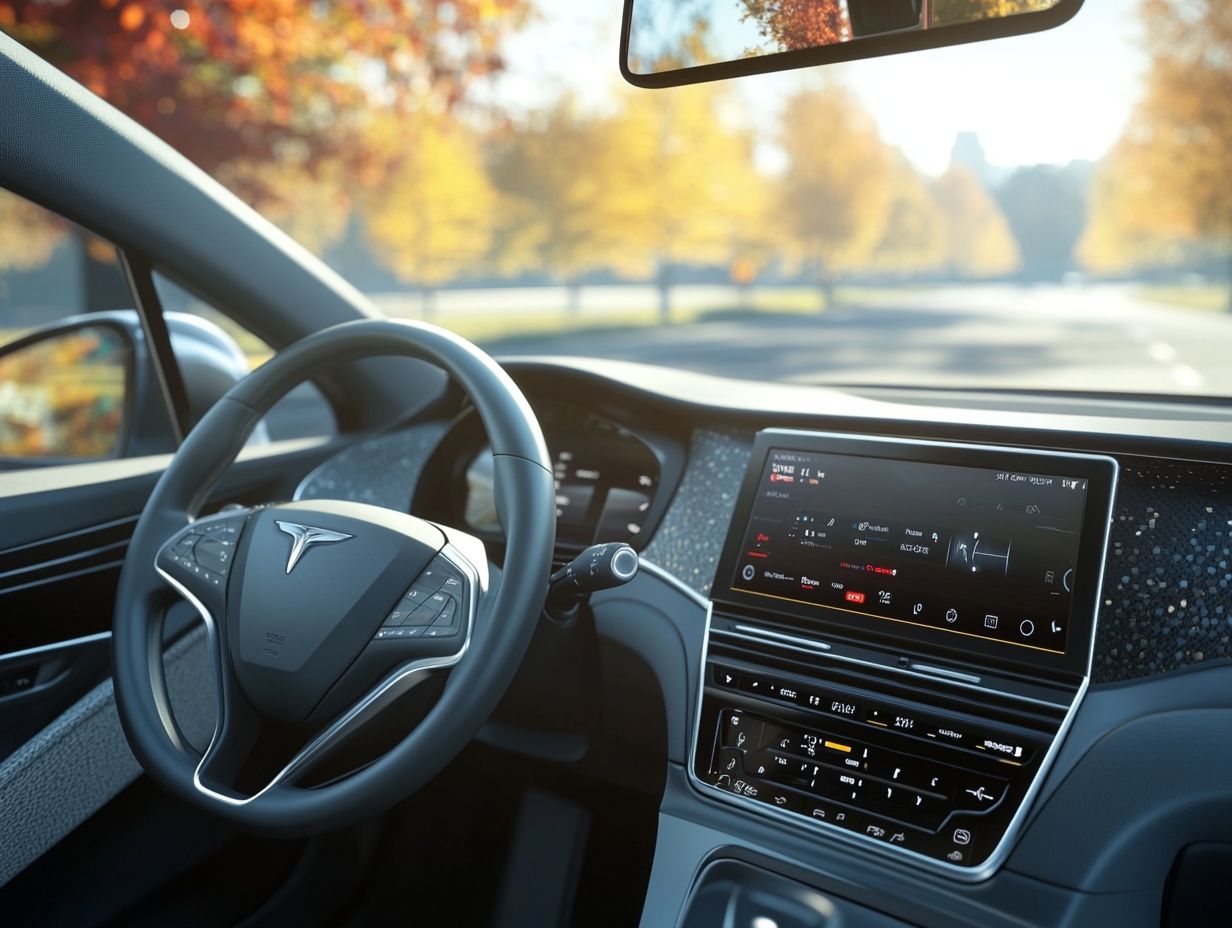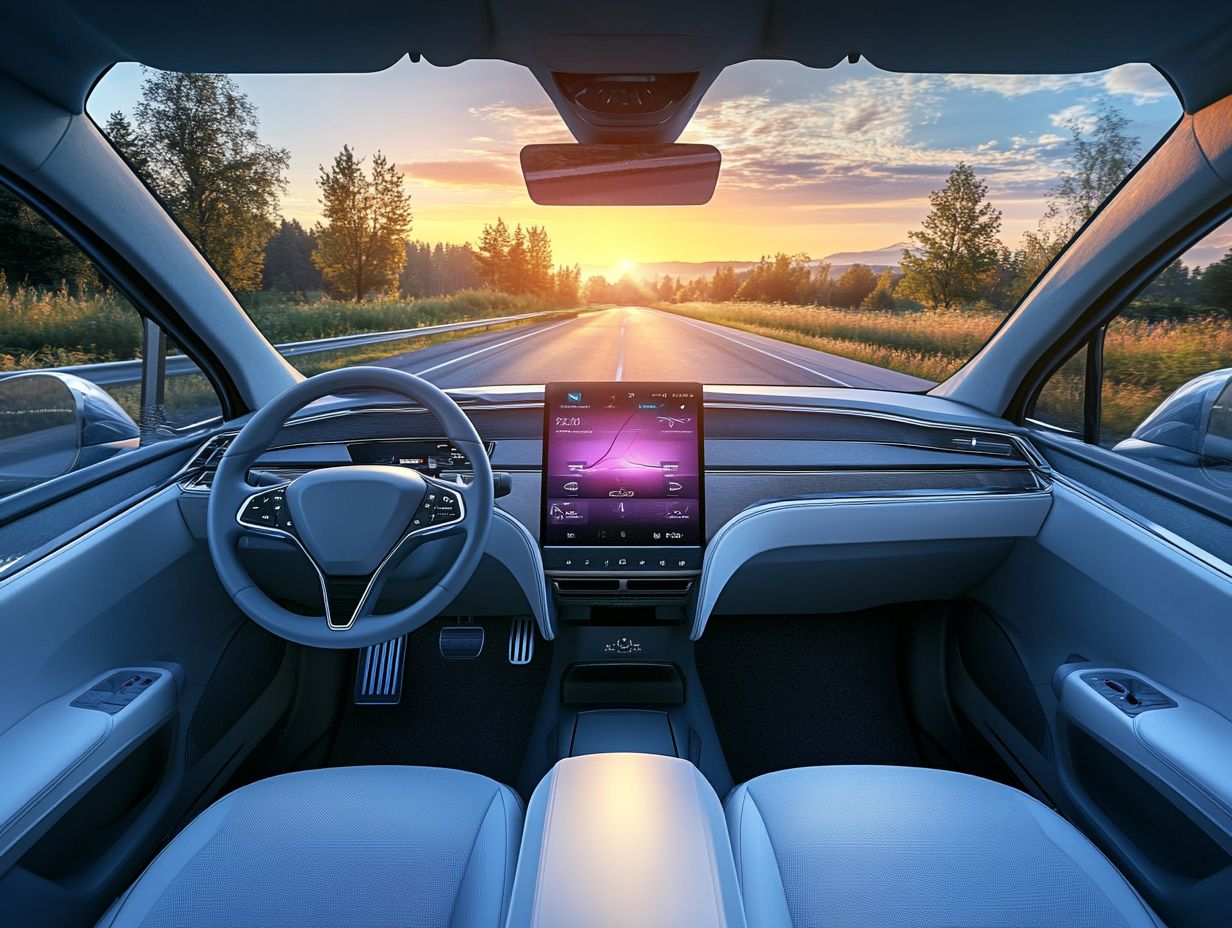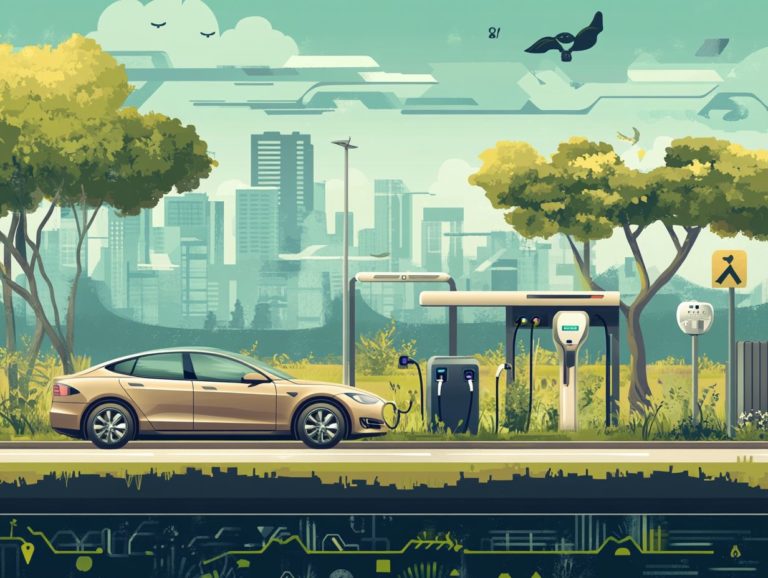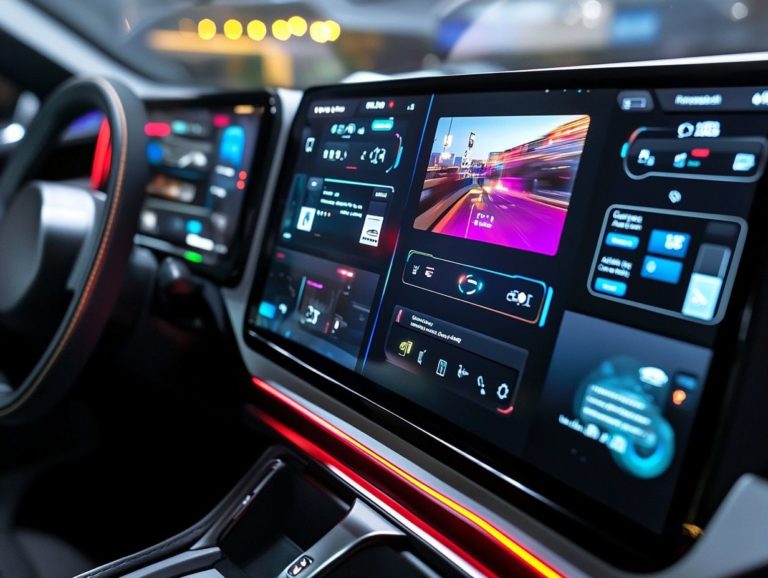Top 7 Must-Have Safety Features for 2024
As vehicle technology continues to evolve, your safety on the road has never been more paramount! Get ready to explore the top seven must-have safety features for 2024 that will change the way you drive!
The 2024 lineup of cars is brimming with innovative safety features crafted to protect not just drivers and passengers, but pedestrians as well. From automatic emergency braking to advanced parking assistance, these technologies elevate your driving comfort and dramatically lower the risk of accidents.
This article will delve into the top seven must-have safety features for 2024, highlighting their benefits, explaining how they function, and showcasing why they could transform your driving experience.
Contents
- Key Takeaways:
- 1. Automatic Emergency Braking
- 2. Lane Departure Warning
- 3. Blind Spot Detection
- 4. Rearview Camera
- 5. Adaptive Cruise Control
- 6. Forward Collision Warning
- 7. Parking Assistance
- What Are the Benefits of Having These Safety Features?
- Frequently Asked Questions
- Want to know the top 7 must-have safety features for 2024? Here they are!
- Why is automatic emergency braking an important safety feature for 2024?
- How does lane departure warning contribute to safety in 2024?
- What is the purpose of blind spot monitoring in 2024?
- How does adaptive cruise control enhance safety for 2024?
- Why is a rearview camera a necessary safety feature for 2024?
- What makes forward collision warning an essential safety feature for 2024?
Key Takeaways:

- Automatic Emergency Braking can help prevent collisions by automatically applying the brakes when a potential crash is detected.
- Lane Departure Warning alerts drivers if they are drifting out of their lane, reducing the risk of accidents caused by distracted or drowsy driving.
- Blind Spot Detection uses sensors to detect vehicles in the driver’s blind spots, providing an extra layer of safety when changing lanes or merging.
1. Automatic Emergency Braking
Automatic Emergency Braking (AEB) is one of those critical safety technologies in modern cars that you ll come to appreciate. It detects potential collisions and automatically engages the brakes, helping to mitigate or even prevent impact. This impressive feature employs smart technology and sensors to analyze real-time driving conditions, significantly enhancing your road safety.
As we move into 2024, AEB-equipped vehicles are becoming a standard safety offering, thanks to their proven effectiveness in reducing crash severity. With such sophisticated safety technologies at your disposal, you can enjoy a newfound sense of security while navigating various driving environments!
The AEB system primarily relies on cameras, radar, and lidar sensors that continuously monitor your surroundings for obstacles, whether they be other vehicles, pedestrians, or cyclists. When the system detects an imminent collision, it quickly calculates the best course of action and can automatically apply the brakes, thereby lessening the force of impact or even avoiding the incident altogether.
Recent studies show that vehicles equipped with AEB can cut rear-end collisions by up to 40%, underscoring its impressive effectiveness. Many car manufacturers, like Subaru and Porsche, now integrate AEB into their comprehensive Driver Assist Packages, ensuring you benefit from this crucial safety feature.
2. Lane Departure Warning
Lane Departure Warning (LDW) systems are essential safety technologies that help you avoid unintended lane drifting. They significantly enhance road safety for both you and your passengers.
These sophisticated systems use a combination of cameras and sensors to continuously monitor your vehicle’s position within its lane. By analyzing the road markings, LDW can quickly alert you if your vehicle starts to veer off course without signaling.
Integrating this technology minimizes accidents caused by driver distraction and plays a vital role in a broader Driver Assist Package. The synergy between LDW and other safety features, like adaptive cruise control and automatic emergency braking, creates a more comprehensive safety net, allowing you to maintain your focus on the road ahead.
3. Blind Spot Detection
Blind Spot Detection enhances your road safety by alerting you to vehicles lurking in your blind spots. This system is often equipped with Blind Spot Monitors.
These systems leverage a sophisticated blend of radar sensors and cameras strategically positioned around your vehicle to keep an eye on adjacent lanes. When another vehicle slips into your blind spot, these sensors spring into action, triggering visual or auditory alerts usually in the form of lights on your side mirrors or warning sounds. This feature becomes particularly crucial when you’re making lane changes, helping you avoid the all-too-common mistake of veering into oncoming traffic.
Additionally, these systems integrate seamlessly with other advanced driver assistance technologies, like lane-keeping aids and adaptive cruise control. Together, they create a robust safety net that significantly lowers the risk of collisions and fosters safer driving habits overall.
4. Rearview Camera
The Rearview Camera is a pivotal safety technology crafted to elevate your road safety by offering a crystal-clear view of what lies behind your vehicle when you’re reversing.
This innovative feature is essential in preventing accidents, especially in crowded parking lots or tight spaces where visibility can be a challenge. By providing you with a wide-angle perspective, it allows you to spot pedestrians, pets, and obstacles that might otherwise slip under your radar.
Many modern systems even come with advanced night vision capabilities. This significantly enhances visibility in low-light conditions, so you can navigate safely when darkness falls.
This technology boosts your awareness and instills a greater sense of confidence in your driving. It s clear that rearview cameras have become a critical component of contemporary automotive design.
5. Adaptive Cruise Control

Adaptive Cruise Control is a smart driver assistance technology designed to elevate your driving experience and enhance road safety. It automatically adjusts your vehicle’s speed, ensuring a safe distance from the car ahead.
This system employs a network of sensors think radar and cameras that continuously monitor traffic conditions and relay crucial information to advanced algorithms. By analyzing this data, it effortlessly accelerates or decelerates, allowing your vehicle to keep pace with others on the road without requiring your constant input.
Such functionality significantly alleviates driver fatigue, especially during long highway journeys. It grants you the freedom to relax while maintaining safe vehicle operation. Adaptive Cruise Control is a vital element of the modern Driver Assist Package, seamlessly integrating multiple technologies to improve both your driving experience and overall safety.
6. Forward Collision Warning
Forward Collision Warning (FCW) systems are critical safety features designed to alert you to potential collisions, playing a crucial role in preventing crashes and bolstering road safety.
These systems leverage a sophisticated array of sensors, including radar and cameras, to continuously monitor your vehicle’s surroundings for any approaching hazards. When an imminent collision is detected, FCW systems spring into action, engaging alert mechanisms like visual warnings on your dashboard or audible alarms, giving you ample time to respond.
<pWhen properly integrated, these systems can significantly reduce accident rates by delivering critical information that prompts timely evasive actions. Modern vehicles often pair FCW with other advanced safety technologies, such as automatic emergency braking and adaptive cruise control. This creates a comprehensive safety framework that enhances your overall driving security.
7. Parking Assistance
Parking Assistance technologies are revolutionizing how you park and drive! They significantly enhance road safety and simplify the challenges of urban parking.
These cutting-edge systems employ a blend of sensors and cameras to detect obstacles and offer real-time feedback. This enables you to maneuver into tight spaces with remarkable ease. With features like automatic steering, your vehicle can occasionally take full control, making the entire parking process almost effortless.
Not only do these technologies reduce the risk of collisions and accidents, but they enhance vehicle safety and boost your confidence behind the wheel.
What Are the Benefits of Having These Safety Features?
The integration of advanced safety technologies in modern vehicles presents numerous benefits. These features significantly enhance road safety, prevent accidents, and boost your confidence behind the wheel.
Innovations like Automatic Emergency Braking and Lane Departure Warning are designed to assist you, reacting in critical moments faster than you can blink. Research from the Insurance Institute for Highway Safety shows that vehicles equipped with these features can reduce rear-end collisions by up to 50%. Lane Departure Warning systems help prevent accidental lane departures, contributing to overall traffic safety.
By lowering the likelihood of accidents, these technologies not only safeguard you and your passengers but also reinforce public trust in the remarkable advancements of automotive safety engineering.
How Do These Features Work?
Modern safety technologies, such as Automatic Emergency Braking and Blind Spot Detection, use a mix of sensors, cameras, and cutting-edge algorithms to elevate your vehicle’s safety.
These systems continuously monitor the environment around you, processing data in real-time to respond quickly to unforeseen hazards. For example, radar and lidar a technology that uses laser light to see collaborate to identify nearby objects, while cameras deliver crucial visual information that helps recognize lane markings and pedestrians.
This web of technology not only helps prevent collisions but also plays a key role in a comprehensive driver assist framework. Features like adaptive cruise control and lane-keeping assistance thrive on this collaborative communication.
As these systems become more seamless and integrated, you can enjoy a heightened sense of security. Drive with confidence knowing that your vehicle is actively managing and adapting to an ever-changing driving landscape.
What Are the Potential Limitations of These Features?

While safety technologies greatly enhance vehicle safety, it s essential to recognize their potential limitations to truly maximize their effectiveness.
For instance, the reliability of sensors can fluctuate based on factors like poor weather or obstructed views, potentially leading to unexpected system failures at critical moments. Some safety features may not work well in specific driving situations, such as navigating tight urban spaces or dealing with sudden road changes. This highlights the importance of being a vigilant driver.
Therefore, it s crucial to maintain a keen awareness of your vehicle’s technological capabilities. Remember, these systems are designed to complement your traditional driving skills, not replace them, ensuring overall road safety.
Are These Features Standard on All Vehicles?
Not all vehicles come with modern safety technologies as standard features. This creates a noticeable disparity in road safety among various models and brands.
This inconsistency in safety offerings presents a challenging landscape for you as a consumer when making informed purchasing decisions. Brands like Porsche and Subaru have integrated advanced safety technologies as standard equipment, significantly enhancing protection for both drivers and passengers.
Conversely, other manufacturers might reserve these essential features for higher trim levels, potentially compromising safety for those on tighter budgets. This variability impacts your choices and raises important questions about the overall effectiveness of road safety initiatives. You need to weigh the value of safety against the price tag.
Curious to learn more about how these features protect you? Read on!
How Can These Features Help Prevent Accidents?
Safety technologies like Automatic Emergency Braking and Blind Spot Detection are essential in your vehicle s arsenal for collision avoidance. They actively work to prevent accidents and safeguard drivers like you.
These advanced features work together to enhance road safety by reducing human error mistakes made by drivers and boosting awareness. For instance, the Automatic Emergency Braking system can sense an impending obstacle in your path. It will automatically apply the brakes if you don t react in time. This technology has demonstrated its effectiveness in real-world scenarios, significantly reducing rear-end collisions, especially in bustling urban areas.
Blind Spot Detection alerts you with visual or auditory signals for vehicles hiding in those tricky blind spots, enabling you to change lanes with increased confidence. Together, these features not only help prevent accidents but also enhance your psychological assurance, knowing that you have dependable systems in place to assist and protect you on the road.
What Other Safety Features Should Be Considered?
Along with the well-known safety features, technologies like Alertness Monitoring and Cybersecurity for Cars are becoming increasingly vital for overall vehicle safety.
These advancements offer real-time assessments of your focus, alerting you if signs of drowsiness or distraction are detected. Cybersecurity is essential as vehicles grow more interconnected, safeguarding complex systems from hacking unauthorized access to your vehicle s systems and malicious attacks.
As automotive technology evolves, the presence of these safety measures reflects a broader commitment to vehicle protection. This delivers peace of mind for you as a driver. With the rising number of electric and autonomous vehicles, ensuring that these intelligent systems remain secure from external threats is paramount in today s automotive landscape.
How Can Drivers Stay Updated on the Latest Safety Features?
Stay updated! Discover the latest safety technologies available for your vehicle, which is essential for enhancing your road safety and grasping the new offerings in modern cars.
In today s rapidly evolving automotive landscape, being informed is crucial for making educated decisions about your vehicle purchases. Regularly engaging with dealership communications, like newsletters or informational sessions, will provide you with vital insights into the latest safety features hitting the market.
Keep an eye on reputable automotive news sources and consumer reports, which offer detailed evaluations and comparisons of various models. By prioritizing your education and staying connected with these resources, you can better understand the benefits of advanced safety technologies, ensuring you drive a vehicle that truly aligns with your safety preferences and lifestyle needs.
Frequently Asked Questions

Want to know the top 7 must-have safety features for 2024? Here they are!
The top 7 must-have safety features for 2024 are: automatic emergency braking, lane departure warning, blind spot monitoring, adaptive cruise control, rearview camera, forward collision warning, and pedestrian detection.
Why is automatic emergency braking an important safety feature for 2024?
Automatic emergency braking is an important safety feature for 2024 because it uses sensors to detect potential collisions and automatically applies the brakes to prevent or reduce the impact of a crash.
How does lane departure warning contribute to safety in 2024?
Lane departure warning helps prevent accidents caused by drifting out of a lane by alerting the driver if the vehicle is crossing lane markings without using a turn signal.
What is the purpose of blind spot monitoring in 2024?
Blind spot monitoring uses sensors to detect vehicles in the driver’s blind spots and alerts them if it is not safe to change lanes, reducing the risk of collisions.
How does adaptive cruise control enhance safety for 2024?
Adaptive cruise control uses sensors and radar to maintain a safe distance from the vehicle in front, making it easier for the driver to keep a safe following distance and avoid rear-end collisions.
Explore these safety features today and stay safe on the road!
Why is a rearview camera a necessary safety feature for 2024?
A rearview camera gives you a clear view of what’s behind your vehicle. This makes reversing and parking much easier, especially in busy places.
What makes forward collision warning an essential safety feature for 2024?
This system alerts you to potential crashes in front of your car. By warning you in time, it helps prevent accidents and keeps you safe on the road.





